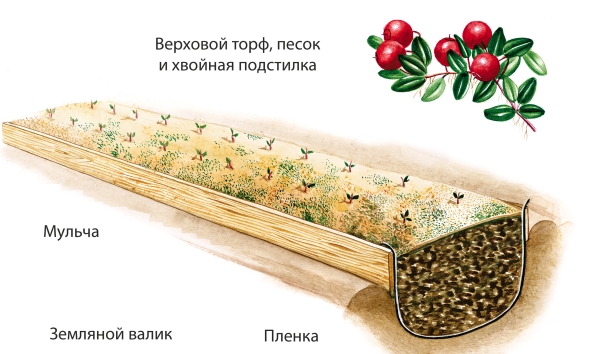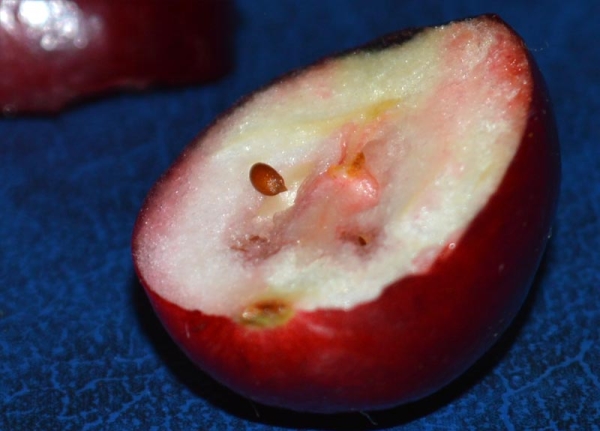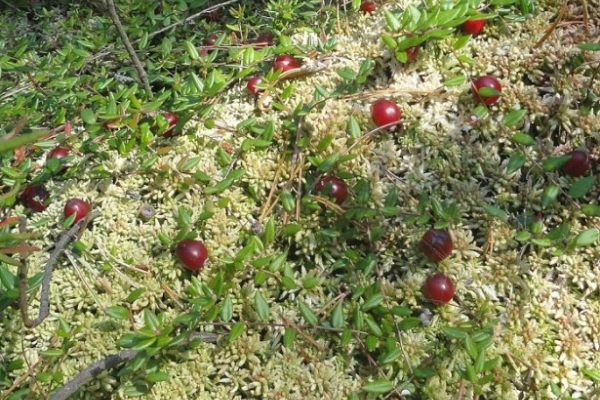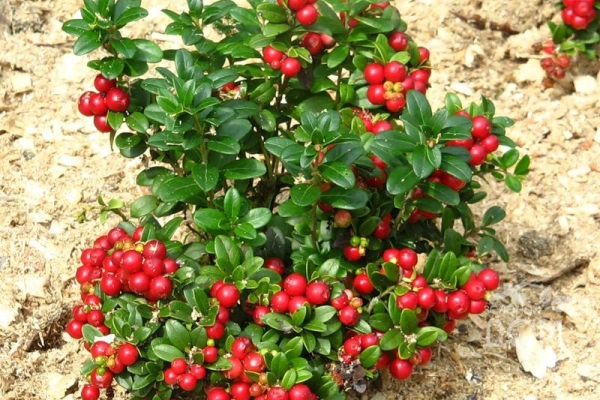Under the name cranberries unite the breed of plants of the heather family, representing creeping shrubs that grow mainly in the northern hemisphere.
Cranberries contain a huge amount of vitamins that are beneficial for the body micro and macro elements, are not high in calories, contain little fat and carbohydrates.
Initially, cranberries were exclusively wild plants and only after the 18th century, breeders were able to bring varieties that are still successfully cultivated in country houses and kitchen gardens.
Table of contents
Where does garden cranberry grow?
Previously, before the cultivation, cranberries grew only in the marshland, where the acidity of the soil was significantly increased. Its homeland is considered North America, and the first researchers of America called it a crane berry.
Only a couple of centuries ago, cranberries were harvested in the swamps, and nowadays cultivation on plantations is being practiced on a large scale, where conditions favorable for growth and conditions that are as close to natural as possible are created.
In Russia, the most common varieties of cranberries received in Karelia, Kostroma and the Leningrad region.
By creating suitable conditions and proper care, the cranberry yield can reach up to 11 tons per hectare of plantings.
Cranberries are now widely used in the production of confectionery, juice drinks and fruit drinks, jams and jelly, and therefore, the cultivation of this plant is not only in demand, but can also become a good source of income.
About the cranberries tell the program "To live is great!":
Requirements for a garden plot for growing
Despite the fact that cranberries are considered to be frost-resistant and unpretentious, growing them in their backyard and suburban areas is considered to be quite a laborious process because of the need to provide a special microclimate and conditions in which it will yield a good harvest.
Land for cultivation before planting young shoots carefully prepared, as this plant feels good in high humidity.
Cranberry is a moisture-loving plant.In this connection, the presence of groundwater will be a significant advantage of the planting area; the depth of their flow is approximately 40 centimeters.
In this case, the best option for growing soil will be peaty, in which the water level is at the optimum level for cranberries. Also suitable for growing loam and sandstone.
It is better to make a plot for planting cranberries among trees or other plantations.which will not interfere with hit of sunshine on it, but, at the same time, will protect it from wind.
How to grow cranberries on your site:
When is it better to plant a berry in the country
Believed to plant and grow cranberries best in spring timeas soon as the land on the site thaws and warms up to 10 cm.
Since the plant develops better in a more acidic soil, then if your site does not have one, you need to clean the top layer of soil to 20-25 centimeters and instead fill it with a mixture of humus, sand, forest land and peat with the addition of rotten needles.
Prepare wells before plantingThey dig them up to a depth of 10 centimeters and a distance of about 20 centimeters between each other, spilling water before planting.
Two seedlings with a height of up to 20 cm are lowered into each well, and the hole is filled up with the prepared soil. It is very important not to overly consolidate the soil after planting, since this can significantly hinder the development of the seedling's root system.

After the first two years of landing, the cranberries will only take root and gain strength - the first berries the plant usually gives three years after planting. Well, already a fully good harvest will be only starting from the fourth year.
The average yield with good care is about a kilogram of two square meters of planted plants.
Cranberries are not planted in autumn in the mainHowever, this time of year is used to prepare the beds for disembarkation.
The main operation of the preparation is to fence the future bed by digging to a depth of up to 20 centimeters of any non-decaying material - plastic, slate.
Landing methods
There are two ways of reproduction and further planting cranberries - generative and vegetative.
Generative - seeded made very rarely and mainly for any breeding experiments, since the resulting plant does not possess the characteristics of its parent.
If your goal is the cultivation of cranberries with certain properties inherent in the maternal escape, it would be better to apply grafting method.
Cranberry cuttings are prepared during the period when their shoots grow intensively. Take green cuttings from 10 centimeters in length and planted in pots with a mixture of peat, sand and rotted needles, or immediately into the soil - to a permanent place.
Cuttings deepen by two or three centimeters, slightly compact the soil around the trunk and abundantly moisturize.

Until rooting of cuttings occurs need to monitor soil moisture - depending on the humidity and temperature conditions, sometimes the bed is watered two or three times a day - under the condition of abundant irrigation of soil with water, shoots take root rather quickly.
If the landing site is under the sun, then it is better to make protection for the cuttings of fabric.
When seed reproduction take ripe fruits of cranberriesrub gently and rinse with water. Selected seeds are planted immediately. This operation is carried out in the spring or before the fall in pots containing peat and a small layer of sand.
Seeds in the soil are covered with glass, irrigated with plenty of water and placed in a warm place accessible to light.After planting the seeds, the soil is regularly watered, and the room, which contains containers with germinating seeds, is aired.
If mold appears on the ground from abundant humidity, they will need to be treated with a fungicide solution.

Average, after three to four weeks with proper care shoots appear, after which it will be necessary to remove the glass, but to keep the mode of abundant watering.
After the shoots have four or five leaves, they are seated — picks up either in pots one sprout, or immediately into the soil of a greenhouse or greenhouse at a distance of 10 centimeters from each other.
The further cultivation of shoots is carried out throughout the year with special care - abundant watering and regular feeding with Kemira solution - at the rate of one tablespoon per 10 liters of water.
Usually, a solution is prepared at the rate of one liter per square meter of a plot with shoots, and when watering it is necessary to make sure that the solution does not fall on the leaves - otherwise it is possible to burn the leaves.
Then the shoots are transplanted to a larger place where they grow for another two or three years.after which you can plant them in a permanent place.
Nuances of care
The main rule for the care of cranberry seedlings for good development and to ensure in the future a rich harvest is ensuring sufficient watering.
Particularly important is the presence of high humidity during the rooting of seedlings, especially at high temperatures.
During the growing season, twice a month, plants are fed with various fertilizer complexes and watering with water containing a weak solution of acids (citric or acetic).
Acidification of the soil the first two or three years after planting can not produce.

For the formation and growth of a large number of fruits must be removed from the plant horizontal shoots, thus stimulating the development of vertical, on which a greater number of fruits develop. This operation is performed in spring or autumn.
For winter in areas with a lack of sufficient snow, cranberries are poured with a layer of peatthat protects the shoots from freezing.
With constant proper care for the plants and the presence of good weather conditions, cranberries will surely please you with a rich harvest of berries.
Garden cranberries:
